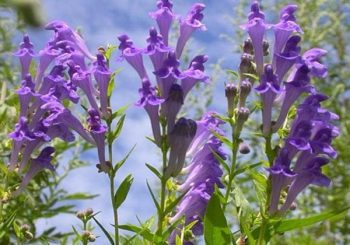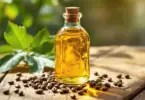Contributing writer for Wake Up World
Upon hearing the word “skullcap,” some people remember the hat that the pope of the Catholic church wears during public appearances. However, skullcap can also refer to two herbs: American skullcap (Scutellaria lateriflora) and Chinese skullcap (Scutellaria baicalensis).
Although these skullcap plants come from the same family, they aren’t interchangeable, and have differences in terms of their uses, physical characteristics and locations where they thrive. For instance, American skullcap is native to North America (although it’s now found in Europe and in other parts of the world), while Chinese skullcap can be traced back to China and parts of Russia.
[pro_ad_display_adzone id=”110028″]
This plant is called “skullcap” because its small blue or purple flowers look like it has a cap on its outer whorl.1 The book “Biotechnology for Medicinal Plants: Micropropagation and Improvement” highlights that skullcap flowers are hooded, tube-shaped and two-lipped, with the upper portion serving as the hood and the lower area possessing two shallow lobes.2
The American skullcap is slender and has many branches, and can grow up to 2 to 4 feet, while the Chinese skullcap plant has single stems that bear blue or purple flowers3 and reaches 30 to 60 cm tall (roughly 1 foot).4 Keep reading this page to learn about American and Chinese skullcap, and see how using them can positively impact your health.
Health Benefits of American Skullcap
Various studies have indicated that American skullcap may help protect against Alzheimer’s disease, Parkinson’s disease,5 anxiety6 and depression7 because of its antioxidant properties.8 This herb can also act as a:9
- Sedative — American skullcap has potential as a treatment for epilepsy, hysteria, panic attacks,10 anxiety and delirium tremens.11 It also helps induce sleep naturally in people with insomnia.12
- Antispasmodic — The herb was used to help clear the throat, and address neuralgia, stress-caused headaches, after-effects of incessant coughing, anorexia nervosa, fibromyalgia and mild Tourette’s syndrome. American skullcap can also be useful for people suffering from withdrawal symptoms from tranquilizers and barbiturates.13
A May 2009 study published in Phytomedicine also highlighted that American skullcap promoted anticonvulsant activities in rats.14
Health Benefits of Chinese Skullcap
Chinese skullcap has antihistamine properties that may help relieve asthma and allergies.15 It also offers antiviral and antibacterial abilities that may work against the following pathogens:16
| Viruses | Bacterial Strains |
|---|---|
|
• Influenza A (H1N1 and H3N3) • Influenza B • Sendai virus (parainfluenza) • Respiratory syncytial virus • Vesicular stomatitis • HIV-1 • Hepatitis A and C • Hepatitis B (resistant and non-resistant) • Coliphage MS2 |
• Chlamydia trachomatis • E. coli • Enterecoccus faecalis • Helicobacter pylori • Klebsiella pneumoniae • Salmonella spp. • Salmonella paratyphi • Shigella flexneri • Staphylococcus aureus (resistant and nonresistant) |
Other properties attributed to Chinese skullcap include:17
- Anti-inflammatory
- Antioxidant
- Nervine
- Neuroprotective
- Anodyne
- Antispasmodic
- Diuretic
- Antifungal
- Anticonvulsant
- Astringent
- Anti-angiogenic
- Febrifuge
- Antitumor
- Antihypertensive
- Expectorant
- Hemostatic
There have been some animal studies suggesting that Chinese skullcap may be effective in alleviating symptoms of diabetes and hypertension or high blood pressure, but more research is needed to see if humans can reap these benefits, too.18
What Is Skullcap Used For?
While both skullcap plants can be used medicinally, different parts of the plants are used. In American skullcap, it’s the leaves that are more useful, while the roots are taken from Chinese skullcap. They are available in powder and capsule forms,19 although you can buy tinctures, teas and extracts as well.20
For around two centuries, it was said that American skullcap was widely used as a mild relaxant and as a form of treatment for anxiety, nervous tension and convulsions.21 Some Native American tribes used American skullcap to treat rabies and schizophrenia, which is why the herb is called mad dog, and stimulate menstrual flow by way of its emmenagogue properties.22 American skullcap was also used during spiritual ceremonies to encourage visions.23
Chinese skullcap is arguably the most-studied skullcap herb. Apart from being grown as an ornamental plant,24 it was prominent in traditional medicine for its ability to address conditions like:25,26,27,28
- Allergies
- Fevers
- Headaches
- Irritability
- Inflammation
- Urinary tract infections29
- Nosebleed
- Jaundice
- Diarrhea
- Dysentery
- Vaginal bleeding30
- Sores, swelling and boils
There is some evidence noting that skullcap can assist with weight loss, although more research is needed to fully confirm this benefit.31,32
How to Grow Skullcap
American skullcap prefers partial shade to full sun, and typically blooms from May to August in USDA zones 4 to 10.33,34 Meanwhile, Chinese skullcap flourishes in sunny areas35 and is known to thrive in sandy and dry soils especially in mountains.36
Skullcap seeds germinate at a naturally high rate (around 75 to 80 percent)37 and fare better if stratified for a week or so. Place the seeds in a sealed plastic bag with moistened vermiculite, sand or a moist paper towel. Keep the bag inside the refrigerator for a week. If you’re using vermiculite, use three times the amount compared to the seeds and moisten sparingly, as increased moisture can cause mold development.38
After the week-long period, start sowing seeds. They can germinate in around two weeks’ time. Begin transplanting the plant outdoors once the threat of frost is gone,39 making sure to put a 12-inch gap in between rows.40
Water the plant moderately and ensure that the soil is moist and well-drained.41 Apart from using seeds, you can propagate skullcaps by dividing roots or cuttings that may spread and clump. A benefit of growing skullcaps this way is for the new plants to protect themselves from major pests.42 Harvest the skullcap plants once flowers are in full bloom. Use a pair of scissors or shears to retrieve the flowers or leaves at least 3 inches above the ground.43
Try This Skullcap Tea Recipe to Reap the Herb’s Benefits
If you’re keen on trying skullcap, here’s a recipe for skullcap tea you can follow:44
Skullcap Tea Recipe
Ingredients
- 1 tablespoon of good-quality skullcap herb
- 2 cups boiling water
Procedure
- Put both ingredients in a teapot and steep for 10 minutes.
- Sweeten with raw honey, Luo han or stevia if preferred.
Preparation time: 10 minutes
This makes 2 servings.
Purchase high-quality skullcap from a reputable source if you want to reap the benefits of this tea.45
Side Effects of Skullcap
Before using skullcap, consult a physician or trusted health expert as the herb is linked to different side effects and interactions. Both American and Chinese skullcaps were said to increase the sedative effects of the following:46
- Anticonvulsants like phenytoin (Dilantin) and valproic acid (Depakote)
- Barbiturates
- Benzodiazepines like alprazolam (Xanax) and diazepam (Valium)
- Insomnia-treating drugs like zolpidem (Ambien), zaleplon (Sonata), eszopiclone (Lunesta) and ramelteon (Rozerem)
- Tricyclic antidepressants like amitriptyline (Elavil)
- Alcohol
- Herbs like valerian, kava and catnip
Pregnant and breastfeeding women must avoid skullcap due to potential complications that can develop. Increased caution must be exercised on some American skullcap varieties, since some were reported to be contaminated with a group of plants that may cause liver problems called germander (Teucrium). To prevent this from happening, only use American skullcap from a reliable source.
American skullcap tinctures, when consumed in high doses, may also trigger adverse effects like giddiness, stupor, mental confusion, twitching, irregular heartbeat and seizures. Meanwhile, Chinese skullcap isn’t recommended for people with stomach or spleen problems, and diabetics.
Excessive consumption of Chinese skullcap can raise a person’s risk for hypoglycemia or low blood sugar levels and increase the effect of diabetes drugs.47 It may also interact with cyclosporines, which are often used to inhibit liver, kidney or heart transplant rejection,48 by preventing their absorption into the body and lessening their overall bioavailability.49
References:
- 1, 3, 8, 18, 20, 21, 25, 45, 46, 47 Milton S. Hershey Medical Center, January 1, 2017
- 2 “Biotechnology for Medicinal Plants: Micropropagation and Improvement,” August 10, 2012
- 4 “Medicinal and Aromatic Plants III,” December 6, 2012
- 5 Front Psychiatry. 2012; 3: 9. Published online 2012 Feb 17. Prepublished online 2011 Dec 30
- 6 British Journal of Wellbeing 2010 1:4, 25-30
- 7 Phytother. Res., 28: 692-698
- 9, 22, 26, 32 “Encyclopedia of Herbal Medicine: 550 Herbs and Remedies for Common Ailments,” July 19, 2016
- 10 HerbalGram. 2009;83:1-2 American Botanical Council
- 11 “Naturally Pain Free: Prevent and Treat Chronic and Acute Pains-Naturally,” July 1, 2012
- 12 “Healing and Wholeness: Complementary and Alternative Therapies for Mental Health,” October 9, 2008
- 13 “Medicinal Plants – Recent Advances in Research and Development,” October 25, 2016
- 14 Phytomedicine. 2009 May;16(5):485-93
- 15 “Allergy Guide: Alternative & Conventional Solutions, Volume 1,” April 3, 2013
- 16, 17 “Healing Lyme Disease Coinfections: Complementary and Holistic Treatments for Bartonella and Mycoplasma,” May 5, 2013
- 19 “Holistic Mental Health- Revised: A Comparison of Traditional and Alternative Treatments for Mental Disorders,” 2009
- 23 Purdue University Horticulture & Landscape Architecture, “Skullcap: Potential Medicinal Crop”
- 24 “The Health and Beauty Botanical Handbook,” January 4, 2018
- 27 “Fundamentals of Pharmacognosy and Phytotherapy E-Book,” April 25, 2012
- 28 “Herbs and Natural Supplements Inkling: An Evidence-Based Guide,” June 24, 2010
- 29 “Natural Treatments for Lyme Coinfections: Anaplasma, Babesia, and Ehrlichia,” February 22, 2015
- 30, 35 “Herbal Antivirals: Natural Remedies for Emerging & Resistant Viral Infections,” October 25, 2013
- 31 J Nurse Pract. 2010 Feb; 6(2): 153–154
- 33 “Herbs: A Color Guide to Herbs and Herbal Healing,” October 24, 2017
- 34 “The Organic Medicinal Herb Farmer: The Ultimate Guide to Producing High-Quality Herbs on a Market Scale,” May 6, 2015
- 36 “Herbal Emissaries: Bringing Chinese Herbs to the West: A Guide to Gardening, Herbal Wisdom, and Well-Being,” 1992
- 37, 39, 41, 43 “Homegrown Herbs: A Complete Guide to Growing, Using, and Enjoying More than 100 Herbs,” April 15, 2015
- 38, 40, 42 Gardening Know How, April 5, 2018
- 44 Just a Pinch, May 25, 2011
- 48 WebMD, “Cyclosporine”
- 49 Planta Med. 2004 Feb;70(2):132-7
Originally published at mercola.com and reproduced here with permission.
About the author:
Born and raised in the inner city of Chicago, IL, Dr. Joseph Mercola is an osteopathic physician trained in both traditional and natural medicine. Board-certified in family medicine, Dr. Mercola served as the chairman of the family medicine department at St. Alexius Medical Center for five years, and in 2012 was granted fellowship status by the American College of Nutrition (ACN).
While in practice in the late 80s, Dr. Mercola realized the drugs he was prescribing to chronically ill patients were not working. By the early 90s, he began exploring the world of natural medicine, and soon changed the way he practiced medicine.
In 1997 Dr. Mercola founded Mercola.com, which is now routinely among the top 10 health sites on the internet. His passion is to transform the traditional medical paradigm in the United States. “The existing medical establishment is responsible for killing and permanently injuring millions of Americans… You want practical health solutions without the hype, and that’s what I offer.”
Visit Mercola.com for more information, or read Dr. Mercola’s full bio and resumé here.
[pro_ad_display_adzone id=”110027″]








